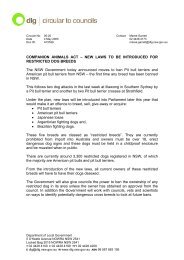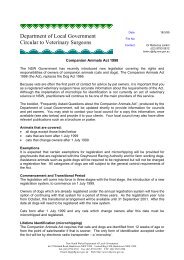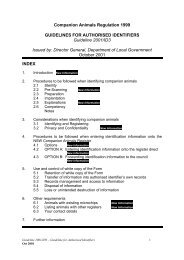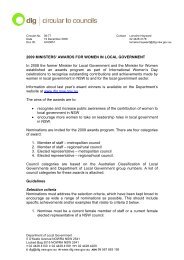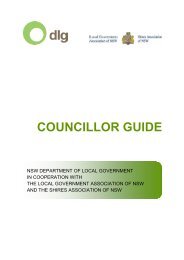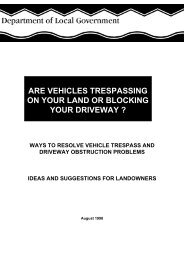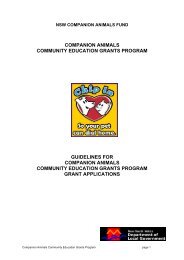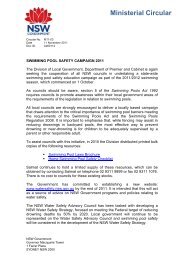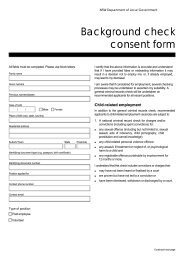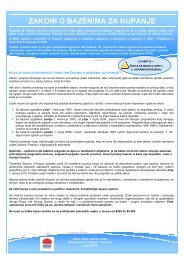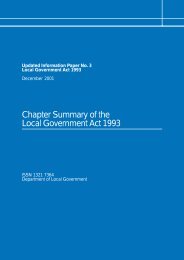section 2 - Division of Local Government
section 2 - Division of Local Government
section 2 - Division of Local Government
Create successful ePaper yourself
Turn your PDF publications into a flip-book with our unique Google optimized e-Paper software.
Section TwoOn-siteSewageManagementStrategies
2.1 INTRODUCTIONCouncils have primary responsibility for controlling on-site sewage management systemsin their areas and are given a wide range <strong>of</strong> powers and functions for this purpose. Theseinclude general community leadership, land use planning, development control, regulation<strong>of</strong> activity, and the provision <strong>of</strong> on-site sewage management services. Preparing an on-sitesewage management strategy (OSMS) is an effective way to set objectives and prioritiseresources.An OSMS provides a formal framework for integrated policy development and serviceplanning, and it should include dynamic links to established processes for regionalcoordination, environmental assessment, statutory planning, service planning, programbudgeting, revenue raising and community accountability. For example, information fromthe OSMS should be used in preparing the Council’s Management Plan, its Annual Report,and its State <strong>of</strong> the Environment Report under the <strong>Local</strong> <strong>Government</strong> Act, as well as relevantdevelopment standards for subdivision, development and building control and councilregulatory and service programs for on-site sewage management.<strong>section</strong> 2The on-site sewage management strategy should take into consideration related strategiesfor water supply, sewerage and stormwater management, as well as catchment managementplans and the views <strong>of</strong> community stakeholders and <strong>of</strong> councils <strong>of</strong> neighbouring areas(especially those within the same water catchment). The views <strong>of</strong> relevant <strong>Government</strong>agencies (including the Department <strong>of</strong> Urban Affairs and Planning, the EnvironmentProtection Authority, NSW Health, the Department <strong>of</strong> Land and Water Conservation andthe Department <strong>of</strong> <strong>Local</strong> <strong>Government</strong>) should also be considered.The “Environmental Guide for the Management <strong>of</strong> <strong>Local</strong> <strong>Government</strong> Water Supply,Sewerage and Drainage” published by the Department <strong>of</strong> Land and Water Conservation(DLWC 1997a) provides an overview <strong>of</strong> relevant environmental management tools andprinciples and is an essential resource for the preparation <strong>of</strong> a local council on-site sewagemanagement strategy.The final form and content <strong>of</strong> the OSMS is a matter for council decision.The OSMS should include:Q a statement <strong>of</strong> the objectives for on-site sewage management in the council’s areaQ a statement <strong>of</strong> specific on-site sewage management goalsQ a statement <strong>of</strong> programs and resources to achieve those goalsQ a statement <strong>of</strong> the evaluation processes to be adopted in relation to those programsQ a commitment to continuing improvement <strong>of</strong> on-site sewage management in thecouncil’s area.The OSMS should be supported by a full assessment <strong>of</strong> the nature and impact <strong>of</strong> existingon-site sewage management systems and <strong>of</strong> the environmental and social factors affectingsystem performance. See Appendix 1 for a sample checklist for a council OSMS.33
2.2 DEVELOPING An on-site sewageMANAGEMENT STRATEGY (OSMS)2.2.1 Policy, Scope and PurposeAn introductory <strong>section</strong> should be provided, including:<strong>section</strong> 2Q background information on the development <strong>of</strong> the OSMSQ the status <strong>of</strong> the strategy, when it was adopted and when it comes into effectQ the scope <strong>of</strong> the strategy, andQ the purpose <strong>of</strong> the strategy.The statement <strong>of</strong> purpose might be:Q to provide a framework to manage and regulate the impact <strong>of</strong> on-site sewagemanagement systems in the area, and to ensure community accountabilityQ to help the council prioritise resources for efficient regulation and monitoring <strong>of</strong> onsitesewage management in the areaQ to coordinate environmental assessment, data collection and monitoring.It is useful to explain how the OSMS relates to other management planning and statutoryplanning processes <strong>of</strong> the council. For example, the <strong>section</strong>s dealing with on-site sewageprograms and funding will provide input to the Management Plan; the <strong>section</strong>s dealingwith environmental assessment, system surveys and mapping will provide input to theState <strong>of</strong> the Environment Report; and the objectives and goals <strong>of</strong> the OSMS will provideinput to the development <strong>of</strong> council policies for subdivision, development and buildingcontrol and for the regulation <strong>of</strong> on-site sewage management systems.A consistent and purposeful approach to on-site sewage management should be emphasisedand a commitment made to continual improvement.2.2.2 ObjectivesThe objectives <strong>of</strong> the council’s OSMS should include:Q protection <strong>of</strong> groundwaterQ protection <strong>of</strong> surface waterQ protection <strong>of</strong> land and vegetationQ prevention <strong>of</strong> public health riskQ maintaining and improving community amenityQ ensuring maximum re-use <strong>of</strong> resources consistent with other objectivesQ ecologically sustainable development.34
Any other objectives that are relevant to local circumstances and consistent with theobjectives specified in these guidelines should be included.2.2.3 GoalsThe OSMS should specify particular goals for the council’s on-site sewage managementfunctions, both in the short and medium term. These will reflect the stage <strong>of</strong> development<strong>of</strong> particular functions and programs and will guide the development <strong>of</strong> new and improvedon-site sewage management programs.The statement <strong>of</strong> goals might be:Q to adopt a partnership approach with households and service agents to support continualimprovement <strong>of</strong> on-site sewage managementQ to build and maintain a database <strong>of</strong> all existing on-site sewage systemsQ to determine the structures and facilities needed to support on-site sewage managementsystemsQ to map and maintain details <strong>of</strong> soil and site conditions and suitability for on-site sewagemanagement systemsQ to provide a training program for operators <strong>of</strong> on-site sewage management systemsQ to consult with householders on the development and implementation <strong>of</strong> a strategy toeliminate illegal discharges from pump-out systemsQ to consult local plumbers and service agents and to specify qualifications for thirdparty certification <strong>of</strong> maintenance work and compliance with approval standardsQ to ensure that all land application areas comply with environment and health protectionstandards and council operating requirementsQ to ensure that all septic tanks are inspected by qualified people at regular intervals andare desludged and maintained as requiredQ to consult Aerated Wastewater Treatment System service agents and to ensure thatmaintenance reports also certify that land application <strong>of</strong> effluent is being done incompliance with site requirementsQ in cooperation with householders, to develop a site-specific sewage management planfor each household using an on-site sewage managementsystemQ to review council development standards andapproval criteria for subdivision, development andbuilding to ensure that appropriate provision ismade for sustainable on-site sewage managementwhen residential development occurs in nonseweredareas.<strong>section</strong> 235
2.2.4 Programs and ResourcesThe Programs and Resources <strong>section</strong> <strong>of</strong> the OSMS should specify the action to be taken toachieve specific goals and general objectives. It might help to distinguish betweenenvironmental assessment, monitoring programs, regulatory programs, service programsand educational programs. It is also appropriate to identify non-council inputs in this <strong>section</strong>.<strong>section</strong> 2The allocation <strong>of</strong> council resources to particular programs and the determination <strong>of</strong> councilrevenue policies are matters for the council’s Management Plan. Clear links should beestablished between the Programs and Resources <strong>section</strong> <strong>of</strong> the WMS and the council’smanagement planning process. Funding proposals for on-site sewage management programsshould be raised in the OSMS and formally adopted in the Management Plan.The consultation process is likely to be more efficient if specific strategies such as theOSMS are released for public exhibition with the Management Plan.Councils are able to raise revenue for on-site sewage management programs and servicesmainly through:Q ordinary rates for general council administration and servicesQ special rates (including fixed-term capital rates) levied on particular parcels <strong>of</strong> landthat have access to, benefit from or contribute to the need for particular programs andservicesQ charges for on-site sewage management services actually provided to particularpropertiesQ approved fees for services (including regulatory services) to peopleQ developer charges (levied under s.64 <strong>of</strong> the <strong>Local</strong> <strong>Government</strong> Act and s.94 <strong>of</strong> theEnvironmental Planning and Assessment Act).Council’s on-site sewage management functions usually relate to specific premises or to aneed arising because <strong>of</strong> activity occurring on specific premises. Some <strong>of</strong> the costs associatedwith new or improved on-site sewage management programs will be recovered fromregulatory fees. Consideration should be given to levying special rates on premises usingon-site sewage management systems, in order to fund environmental assessment, monitoringand reporting and community education programs. The appropriate revenue mix for onsitesewage management activities is a matter for each council to consider in the context <strong>of</strong>the OSMS and the council’s Management Plan.The development and determination <strong>of</strong> council planning policies and regulatory policiesare matters that must be dealt with in accordance with relevant legislative frameworks.Existing policies concerning on-site sewage management issues should be listed as resources,and clear links should be established between goals and programs specified in the OSMSand the council planning and regulatory policy development processes.36
All relevant legislation, regulations, planning instruments, development standards and localpolicies should be identified in the Programs and Resources <strong>section</strong>. Important provisionsshould be noted and copies <strong>of</strong> relevant documents should be made available. Counciladministrative arrangements, codes <strong>of</strong> practice and operating procedures should beidentified.Specific on-site sewage management plans can be prepared for particular localities as ameans <strong>of</strong> coordinating different system management requirements in environmentallysensitive areas or <strong>of</strong> specifying technical limitations arising because <strong>of</strong> site conditions andavailable services. When such plans are prepared, they should be identified in the Programsand Resources <strong>section</strong> in a schedule that shows:Q which areas have on-site sewage management plans that are being implementedQ which areas have plans that are being developedQ which areas are nominated for future on-site sewage management plans.<strong>section</strong> 2A risk management plan that assesses pollution risks and sets out detailed action to betaken in specific circumstances should be included in the Programs and Resources <strong>section</strong>.37
2.2.5 EvaluationThe Evaluation <strong>section</strong> <strong>of</strong> the OSMS should include performance indicators for key goalsand programs and arrangements for the ongoing evaluation <strong>of</strong> program effectiveness.Performance indicators should use existing data collections where possible and should bereported in measurable or quantifiable terms that are meaningful to councillors, staff andthe community.<strong>section</strong> 2The initial implementation effort for new programs could be demanding, and progresstargets should be referenced to reinforce the objective <strong>of</strong> continual improvement.An example <strong>of</strong> the use <strong>of</strong> performance indicators is set out in Table 2 .Table 2:Example Performance Indicators for the OSMSGoalsPerformance Indicator/Target• to survey and maintain a database <strong>of</strong> allexisting systems• to map and maintain details <strong>of</strong> soil andsite conditions for on-site sewagemanagement• to provide a training program forhouseholds using on-site sewagemanagement systems• to ensure that land application areascomply with management requirements• to ensure all septic tanks are inspected byqualified people at regular intervals andare desludged and maintained as requiredfor effective performance• number <strong>of</strong> surveys entered each year• proportion <strong>of</strong> total entered each year• complete surveys <strong>of</strong> 75% <strong>of</strong> existingsystems within three years• all identified high risk areas in two years• at least 90% <strong>of</strong> new residentialsubdivision and developmentapplications in three years• at least 75% <strong>of</strong> applications for new orupdraded on-site systems in three years• develop a communications strategyincluding information, education andfield workshop components to pilot stagein two years• provide household information packs toall operators within one year• specify requirements for land applicationareas in LOP/LAP in one year• develop and implement effectiveinspection and enforcement strategies intwo years• 95% <strong>of</strong> areas to comply in three years• develop and implement maintainancepolicies for all septic tanks in two years• determine who is qualified to inspect andcertify septic tanks in one year• no fewer than 95% <strong>of</strong> all septic tanks tobe desludged at least once every fiveyears38
2.2.6 Continuing ImprovementThe OSMS should contain a commitment by the council to continuing improvement in theregulation and operation <strong>of</strong> on-site sewage management systems. There is no underestimatingthe size <strong>of</strong> the task that councils face to address poor on-site sewage management practicesand to achieve the basic environment and health protection objectives <strong>of</strong> these guidelines.Consequently, the OSMS should be a dynamic and evolving process <strong>of</strong> continualimprovement.The results <strong>of</strong> the evaluation and monitoring programs adopted under the OSMS will showwhere deficiencies and strengths are, and where changes may need to be made. Newtechnology will emerge that may prompt councils to re-evaluate the preferred systems.Ideally, council should review the OSMS each year as part <strong>of</strong> its management planningprocess, and should do a major review at least once every four years.<strong>section</strong> 22.2.7 AttachmentsAppendicesAlthough the OSMS is essentially a strategic management document, it might be appropriateto include or reference technical guidelines (for example, for site assessment, irrigationarea calculations, system selection, operation and monitoring) as appendixes.GlossaryInclude a glossary to explain any difficult or uncommon terminology.ReferencesInclude full references.39




